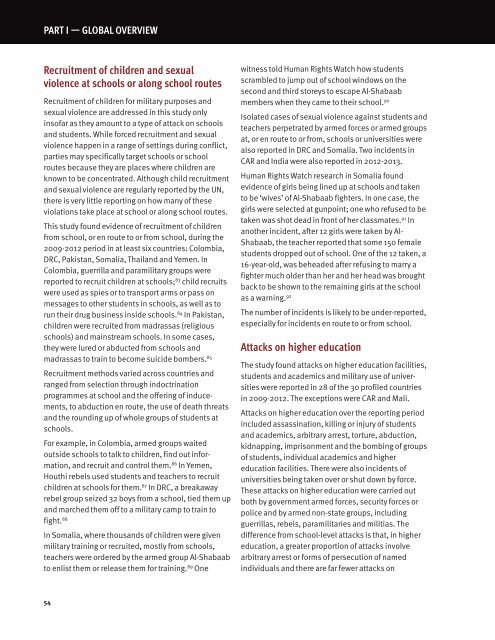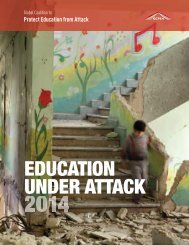Create successful ePaper yourself
Turn your PDF publications into a flip-book with our unique Google optimized e-Paper software.
PART I — GLOBAL OveRvIeWRecruitment of children and sexualviolence at schools or along school routesRecruitment of children for military purposes andsexual violence are addressed in this study onlyinsofar as they amount to a type of attack on schoolsand students. While forced recruitment and sexualviolence happen in a range of settings during conflict,parties may specifically target schools or schoolroutes because they are places where children areknown to be concentrated. Although child recruitmentand sexual violence are regularly reported by the UN,there is very little reporting on how many of theseviolations take place at school or along school routes.This study found evidence of recruitment of childrenfrom school, or en route to or from school, during the2009-2012 period in at least six countries: Colombia,DRC, Pakistan, Somalia, Thailand and Yemen. InColombia, guerrilla and paramilitary groups werereported to recruit children at schools; 83 child recruitswere used as spies or to transport arms or pass onmessages to other students in schools, as well as torun their drug business inside schools. 84 In Pakistan,children were recruited from madrassas (religiousschools) and mainstream schools. In some cases,they were lured or abducted from schools andmadrassas to train to become suicide bombers. 85Recruitment methods varied across countries andranged from selection through indoctrinationprogrammes at school and the offering of inducements,to abduction en route, the use of death threatsand the rounding up of whole groups of students atschools.For example, in Colombia, armed groups waitedoutside schools to talk to children, find out information,and recruit and control them. 86 In Yemen,Houthi rebels used students and teachers to recruitchildren at schools for them. 87 In DRC, a breakawayrebel group seized 32 boys from a school, tied them upand marched them off to a military camp to train tofight. 88In Somalia, where thousands of children were givenmilitary training or recruited, mostly from schools,teachers were ordered by the armed group Al-Shabaabto enlist them or release them for training. 89 Onewitness told Human Rights Watch how studentsscrambled to jump out of school windows on thesecond and third storeys to escape Al-Shabaabmembers when they came to their school. 90Isolated cases of sexual violence against students andteachers perpetrated by armed forces or armed groupsat, or en route to or from, schools or universities werealso reported in DRC and Somalia. Two incidents inCAR and India were also reported in 2012-2013.Human Rights Watch research in Somalia foundevidence of girls being lined up at schools and takento be ‘wives’ of Al-Shabaab fighters. In one case, thegirls were selected at gunpoint; one who refused to betaken was shot dead in front of her classmates. 91 Inanother incident, after 12 girls were taken by Al-Shabaab, the teacher reported that some 150 femalestudents dropped out of school. One of the 12 taken, a16-year-old, was beheaded after refusing to marry afighter much older than her and her head was broughtback to be shown to the remaining girls at the schoolas a warning. 92The number of incidents is likely to be under-reported,especially for incidents en route to or from school.Attacks on higher educationThe study found attacks on higher education facilities,students and academics and military use of universitieswere reported in 28 of the 30 profiled countriesin 2009-2012. The exceptions were CAR and Mali.Attacks on higher education over the reporting periodincluded assassination, killing or injury of studentsand academics, arbitrary arrest, torture, abduction,kidnapping, imprisonment and the bombing of groupsof students, individual academics and highereducation facilities. There were also incidents ofuniversities being taken over or shut down by force.These attacks on higher education were carried outboth by government armed forces, security forces orpolice and by armed non-state groups, includingguerrillas, rebels, paramilitaries and militias. Thedifference from school-level attacks is that, in highereducation, a greater proportion of attacks involvearbitrary arrest or forms of persecution of namedindividuals and there are far fewer attacks on54



